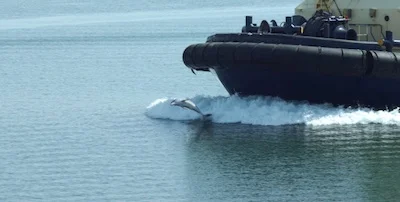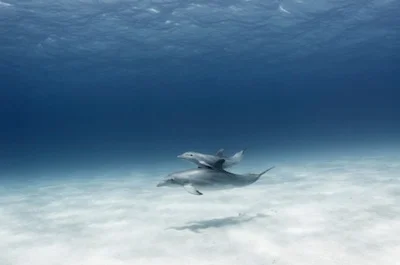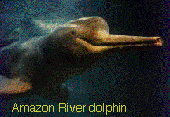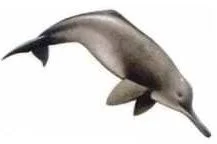Dolphins are not fish.
They are small whales.
They are animals that live in the sea.
They breathe air like we do.
They have skin, not scales.
Dolphins are small whales. They are in the group of whales known as toothed whales.
A pair of bottlenose dolphins breaching -leaping clear out of the water. ©Getty Images
Cetaceans (say see-tay-shuns) are mammals, which means they breathe air, give birth to live young that drink milk from their mother's body.
The dolphin has a very close relative, the porpoise (say por-puss), and the two are so similar that for a long time the words were interchangeable as though they were different names for the same animal. However, the 6 species (kinds) of porpoise have blunt heads - they do not have the beak and melon-shaped foreheads that dolphins have. Porpoises have small spade-shaped teeth.
Dolphin teeth are cone-shaped, and the top and bottom teeth interlock. They have a melon-shaped head, most have a beak, and many small pointed teeth. They have a dorsal fin, which stands up on their back.
Dolphins have small pointed teeth ©Getty Images
Most dolphins live in shallower parts of oceans in warm and temperate areas of the world.
Dolphins swim about 250m below the surface of the sea, and can hold their breath for about 15-20 minutes. They use echo-location to navigate and find food. This means they make a high-pitched sound that bounces off objects around them, and then listen to the echoes, which they use to locate and identify the objects.
Dolphins are highly intelligent and playful. They are very social , and live in groups that can be as many as several hundred.
They frequently pop their heads out of the water to see their surroundings, a habit known as 'spy hop'.
A dolphin bow-riding at the front of the boat. ©Getty Images
Groups also swim alongside ships, using the wave created by the ship's bow (the pointy bit at the front, pronounced like bough), which is called 'bow-riding'. Scientists think is a way of conserving energy.
Diet
Dolphins eat a variety of prey such as fish, squid and crustaceans. Groups hunt together, surrounding a school of fish and taking turns to swim through the fish and catching some. They also follow fishing boats to feed on fish that may be thrown overboard or drop from the nets.
Life Cycle
A dolphin and calf. ©Getty Images
Female dolphins give birth to a single calf, very rarely twins, 9-17 months after mating with a male. The length of time depends on the species.
The calf is born tail first, and as soon as the head appears, the calf is guided to the surface to breathe. It suckles its mother's milk for about 1-2 years.
There are 2 groups of dolphin: short-beaked and long-beaked. There are around 42 species, or kinds, of dolphin, including bottlenose dolphin, Risso's dolphin, false killer whale, Pacific white-sided dolphin, orca whale (the biggest dolphin), longfinned pilot whale, shortfinned pilot whale, and Irrawaddy dolphin.
One of the best known dolphins, the bottlenose. ©Getty Images
Freshwater Dolphins
Most dolphins live in the oceans, but a few species, or kinds, live in fresh water. There are four species of these dolphins, called river-dolphins. As their name suggests, they live only in rivers. They all have a long, slender beaks with many teeth. They have small eyes. Their dorsal fins are less developed than those of ocean dolphins, and their bodies are thicker. They live in muddy river estuaries (where a river meets the sea) and rely on excellent echolocation (sounds that are sent out and bounce back off objects in their path) in order to find their way about.
An illustration of the Indus river-dolphin. ©Getty Images
The existing river-dolphin species are:
the Indian river-dolphin (sometimes known as the Ganges river-dolphin),
the Indus river-dolphin, which is almost blind.
the Amazon river-dolphin (called boto),
the La Plata dolphin.
All river-dolphins are threatened or endangered.
A Recent Extinction
Now extinct: baiji, or the Yangtze river-dolphin.
Extinct means gone forever, there are none left. On 8th August 2007, it was officially confirmed that the Yangtze river- dolphin (baiji) was extinct after an intense six-week search failed to find even a trace of one in the whole 1,669 km of the Yangtze River. The extinction of this rare animal was suspected in 2006, but is now confirmed. The team of searchers, which included Chinese government scientists and other conservation experts, used two boats and searched the river four times, listening and looking for the dolphins. The Chinese government had intended the team to find Yangtze river-dolphins and move them to a new, protected, reserve in a lake as part of a program designed to save them. Sadly, this attempt came too late.
The Yangzte river-dolphin numbers had been dropping steadily. They were declared endangered in 1979. In 1998 only 7 were found. The last captive baiji died in 2002. The Yangtze River is so heavily polluted that it may never recover. It is a major shipping traffic area.
A New Dolphin!
An Australian snub-fin dolphin
In 2005, scientific tests proved that small dolphins in Australian coastal waters thought to be Irrawaddy dolphins were in fact a different, previously unknown species. They have been named the Australian snub-fin dolphin. The 1.5m animals are social, living in groups.
This species of dolphin has a very blunt, round head and a small blunt, triangular dorsal fin. They are found across Australia's northern coast from the Kimberley to the Gladstone area of Queensland, in tidal creeks where they enter the sea, in rivers and mangroves, in water less than 15m deep.
They feed on fish, squid and prawns which they catch by spitting jets of water, which is thought to confuse its prey. Their numbers are not known but they are classified as Near Threatened.
It’s a good idea to get information from more than one source!
Read about dolphins
https://www.activewild.com/facts-about-dolphins-for-kids/
https://www.sciencekids.co.nz/sciencefacts/animals/dolphin.html
Watch a video about dolphin parenting
Watch a video about dolphins, how they communicate, about echolocation, and how calves learn what they need to know.










